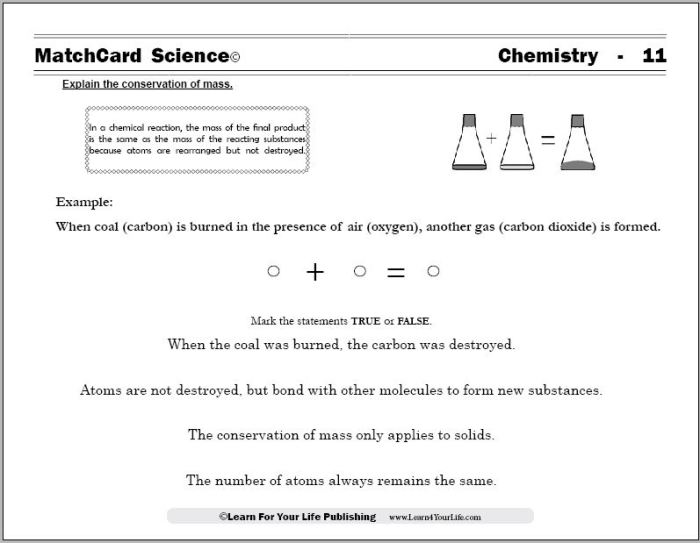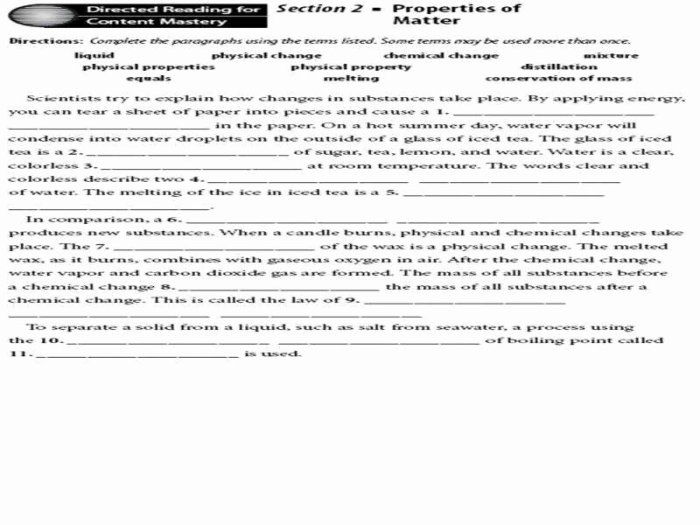Introducing the Law of Conservation of Mass Worksheet, an educational resource that explores the fundamental principle of mass conservation in a captivating and comprehensive manner. This worksheet delves into the concept of mass conservation, its significance in chemistry, and its applications in various fields, making it an invaluable tool for students and educators alike.
Throughout this worksheet, we will embark on a journey of discovery, investigating how mass remains constant during chemical reactions, examining the role of reactants and products, and exploring the limitations of this law in certain scenarios. With interactive exercises and thought-provoking questions, this worksheet promises an engaging and enriching learning experience.
Law of Conservation of Mass
The law of conservation of mass states that the total mass of a closed system remains constant, regardless of changes in state or composition of the system.
In other words, mass cannot be created or destroyed, only transferred or rearranged.
Examples of the Law of Conservation of Mass in Everyday Life
- When you burn a candle, the mass of the candle decreases as it burns, but the total mass of the candle and the wax that drips down remains the same.
- When you dissolve salt in water, the mass of the salt and the mass of the water remain the same, even though the salt is now dissolved in the water.
Significance of the Law of Conservation of Mass in Chemistry
The law of conservation of mass is one of the fundamental laws of chemistry. It is used to:
- Balance chemical equations
- Determine the composition of compounds
- Calculate the amount of reactants and products in a chemical reaction
Law of Conservation of Mass in Chemical Reactions: Law Of Conservation Of Mass Worksheet

The law of conservation of mass applies to chemical reactions. In a chemical reaction, the total mass of the reactants is equal to the total mass of the products.
This is because the atoms that make up the reactants are rearranged to form the products, but no atoms are lost or gained.
Role of Reactants and Products in Chemical Reactions
Reactants are the substances that are present at the beginning of a chemical reaction. Products are the substances that are formed at the end of a chemical reaction.
The law of conservation of mass states that the total mass of the reactants is equal to the total mass of the products.
Examples of Balanced Chemical Equations that Demonstrate the Law of Conservation of Mass
The following is an example of a balanced chemical equation:
2H 2+ O 2→ 2H 2O
In this equation, the total mass of the reactants (2H 2+ O 2) is equal to the total mass of the products (2H 2O).
Applications of the Law of Conservation of Mass

The law of conservation of mass has many applications in various fields, including:
- Stoichiometry
- Balancing chemical equations
- Determining the composition of compounds
Limitations of the Law of Conservation of Mass, Law of conservation of mass worksheet
The law of conservation of mass is not always applicable. In some situations, mass can be created or destroyed.
For example, in nuclear reactions, mass can be converted into energy, and in special relativity, mass can be converted into energy and vice versa.
Worksheets and Activities

| Worksheet/Activity Type | Grade Level | Description |
|---|---|---|
| Balancing Chemical Equations | High School | Students are given a list of unbalanced chemical equations and asked to balance them using the law of conservation of mass. |
| Determining the Composition of Compounds | College | Students are given a sample of a compound and asked to determine its composition using the law of conservation of mass. |
Frequently Asked Questions
What is the Law of Conservation of Mass?
The Law of Conservation of Mass states that mass can neither be created nor destroyed in a closed system, meaning the total mass of the reactants in a chemical reaction is equal to the total mass of the products.
How does the Law of Conservation of Mass apply to chemical reactions?
In chemical reactions, the mass of the reactants is equal to the mass of the products. This is because atoms are neither created nor destroyed during a chemical reaction, only rearranged.
What are the limitations of the Law of Conservation of Mass?
The Law of Conservation of Mass does not apply to nuclear reactions, where mass can be converted into energy and vice versa, or in special relativity, where mass can change with velocity.